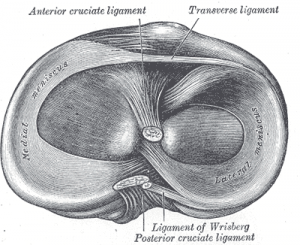Hypermobile Meniscus
Top Contributors - Robert Pierce, Madisyn Melchor, Kim Jackson, Matt Huey, Cindy John-Chu and Briana Marin
Top Contributors - Robert Pierce, Madisyn Melchor, Kim Jackson, Matt Huey, Cindy John-Chu and Briana Marin
Clinically Relevant Anatomy
[edit | edit source]
Lateral meniscus hypermobility (LMH) is excess motion at the lateral meniscus that can cause lateral knee pain or tenderness, locking of the knee, or limitation of the range of motion during knee flexion. (Beel) (Kamiya) It is a rare, uncommon condition. (Beel)
The menisci are crescent shaped, cartilaginous discs that lie between the articular cartilage of the femur and tibia. The menisci have various functions - load transmission, shock absorption, joint lubrication, nutrition, secondary mechanical stability, and guiding of movements. (MSK Knee PPT)
In a stable knee, the lateral meniscus is smaller, thinner, and more mobile than the medial meniscus. In addition, the lateral meniscus has less stabilizers at its posterolateral aspect. (Beel) The stabilizers of the lateral meniscus include the – popliteomeniscal fascicles (PMF), the posterior capsule, the meniscofemoral ligaments, and the posterior meniscotibial ligament. (Beel) These attachments to the posterior knee prevent the subluxation of the posterior horn of the lateral meniscus into the knee joint. (Orthosports)
Mechanism of Injury / Pathological Process
[edit | edit source]
LMH is thought to be related to a congenital deficiency in the capsular attachments (Steyn), or an atraumatic injury to the ligamentous attachments (Orthosports), specifically the PMF (Kamiya). Trauma that causes rupture to the PMF can be insignificant, so patients may not recall a specific mechanism of injury.
Commonly, hypermobility is due to an overuse injury, as well as atraumatic hypermobility. An isolated incidence of LMH is rare. Studies have found that in many cases of anterior cruciate ligament (ACL), and/or posterolateral injuries to the knee there is concurrent damage to the PMF, which may result in LMH.
Clinical Presentation[edit | edit source]
Symptoms include painful popping or locking with the knee in flexion and/or external rotation. Pain can be reproduced through application of a varus force when the hip and knee are placed in flexion and external rotation (FABER).
Diagnostic Procedures[edit | edit source]
add text here relating to diagnostic tests for the condition
Outcome Measures[edit | edit source]
add links to outcome measures here (see Outcome Measures Database)
Management / Interventions
[edit | edit source]
add text here relating to management approaches to the condition
Differential Diagnosis
[edit | edit source]
· Bucket-handle Meniscal Lesion
· Anterior Cruciate Ligament (ACL Tear)
· Ligamentous Instabilities
· Articular Cartilage lesions
· Patellar Dislocation
· Patellar Pathology
Resources
[edit | edit source]
add appropriate resources here







